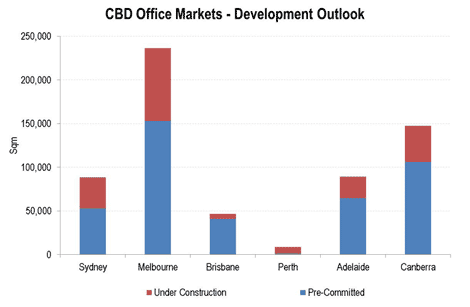Coalition victory could mean 'toe cutting' and spell bad news for investors in Canberra office market: BIS Shrapnel
A Coalition victory at the next federal election could result in demand for office space in Canberra falling even further than the current gloomy projections by BIS Shrapnel.
In anew forecast report, BIS Shrapnel expects the Canberra office vacancy rate to remain above 10% over the next three years – compared with a low vacancy rate in the single digits in the previous decade – while supply increases by 7%.
Report author and senior project manager Christian Schilling warns that austerity measures by the Commonwealth government are now depressing demand for office space, while more construction will add 140,000 square metres of new supply over the coming two years.
Canberra has the second highest pipeline of new office projects – behind Melbourne (about 240,000 square metres).
Click to enlargeSource: Jones Lang LaSalle
Under its “base case scenario” BIS Shrapnel does not expect to see much improvement until two to three years from now, with the outlook worse for non-civic office space.
However, Schilling warns that there is a “significant ‘other’ scenario”:
“A change of government late next year could bring the toe-cutters back.
“Demand for office space could turn negative if the new government cuts a swathe through the public service.”
“That could cause a further setback to a market already reeling from the excesses of last decade.
“We are not in the business of forecasting election outcomes,” says Schilling. “But anyone in the market would do well to run this outlook as an alternative scenario in their forward planning.”
“It’s the 500-pound gorilla in the room,” he says.
Canberra is currently undergoing its second major office downturn since the late 1990s, in what was previously a “paradigm for stable progress, the perfect place for counter-cyclical investment”.
“Since then, the market has seen large cyclical fluctuations in demand for and supply of office space. They were brought about by changes in government, reforms and efficiency drives, periodic under-investment and sudden surges in employment,” Schilling says.
“Add a dose of commitment to sustainability that leaves non-complying buildings out in the cold, plus private over-building and you have a recipe for instability that (almost) mimics the cyclicality in the other capital city markets,” Schilling adds.
According to BIS Shrapnel, a massive construction boom from 2002 to 2012 resulted in Canberra being highly oversupplied, with vacancies reaching record levels across both civic (15.6%) and non-civic (13.4%) sectors by 2010.
Strong leasing demand subsequently made solid inroads into that surplus, underpinned by Commonwealth employment growth as a result of GFC-induced stimulus spending, but demand has cooled since then.
The Commonwealth government has introduced austerity measures in order to return the budget to the black.
“The federal government has literally turned off the (money) tap,” says Schilling. “There simply isn’t any money in the till to fund the cost of fitting out new premises, with the powerful PwC (PricewaterhouseCoopers) keeping a watchful eye on capital expenditure.”
Figures compiled recently by Jones Lang LaSalle show that Canberra recorded a fourth successive quarter of positive net absorption in the second quarter of 2012 (7,800 square metres) taking the total to 47,600 square metres for the 2011-12 financial year, with the vacancy rate tightened to 9.9% – the first time vacancy has been below 10% since the fourth quarter of 2009.
New office buildings include Nishi Commercial – part of developer the Molonglo Group’s mixed-use NewActon project, which has recorded strong leasing activity – helped by its status as one of Canberra’s greenest office building projects.
Nishi is now 80% leased as demand grows for premium-grade office stock with high environmental ratings, according to Colliers.
Just two floors out of the 10 remain available for lease, with office tenants set to move across in November.
